Ubuntu16.04下沙盒数据导入到 Neo4j 数据库(图文详解)
不多说,直接上干货!
参考博客
http://blog.csdn.net/u012318074/article/details/72793914 (表示感谢)
前期博客
Neo4j沙盒实验申请过程步骤(图文详解)
Ubuntu16.04下Neo4j图数据库官网安装部署步骤(图文详解)(博主推荐)
首先,查看下你的操作系统的版本。

root@zhouls-virtual-machine:~# cat /etc/issue
Ubuntu 16.04.1 LTS \n \l root@zhouls-virtual-machine:~#
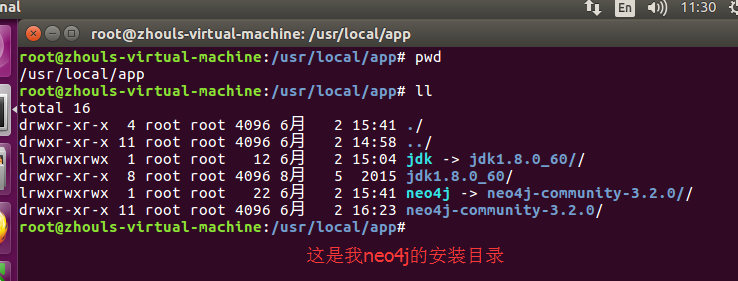
这篇文章就来介绍一下我将 Neo4j 沙盒中的数据导入到自己的 Neo4j 数据库的方法。大家可以清楚的看到沙盒数据公开了很多,我这里,仅此network-management。


使用 github 上的源数据:https://github.com/neo4j-contrib/sandbox-guides
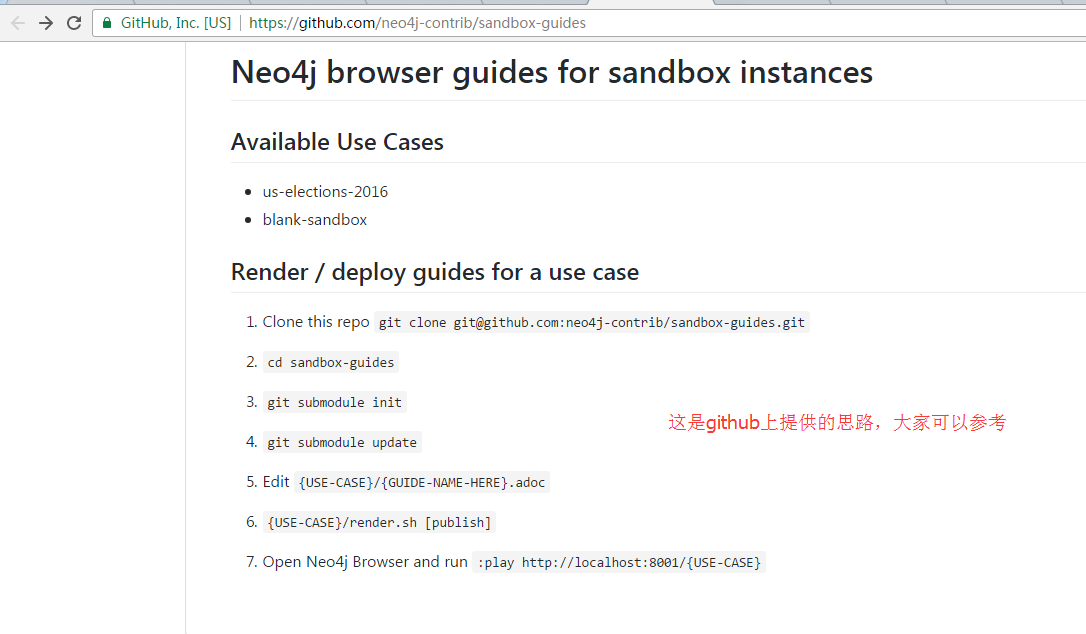
Neo4j browser guides for sandbox instances
Available Use Cases
- us-elections-2016
- blank-sandbox
Render / deploy guides for a use case
Clone this repo
git clone git@github.com:neo4j-contrib/sandbox-guides.gitcd sandbox-guidesgit submodule initgit submodule updateEdit
{USE-CASE}/{GUIDE-NAME-HERE}.adoc{USE-CASE}/render.sh [publish]Open Neo4j Browser and run
:play http://localhost:8001/{USE-CASE}
第一步:克隆下载
Clone this repo
git clone git@github.com:neo4j-contrib/sandbox-guides.git
选择一个要存放这个数据的文件夹,我存放的目录为/usr/local/app/neo4j-community-3.2.0/data/databases,使用 Git 方法下载文件,在目录下执行
root@zhouls-virtual-machine:/usr/local/app/neo4j-community-3.2.0/data/databases# git clone https://github.com/neo4j-contrib/sandbox-guides.git
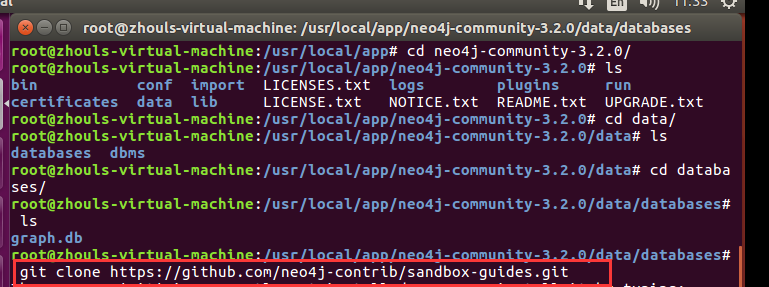
root@zhouls-virtual-machine:/usr/local/app# cd neo4j-community-3.2./
root@zhouls-virtual-machine:/usr/local/app/neo4j-community-3.2.# ls
bin conf import LICENSES.txt logs plugins run
certificates data lib LICENSE.txt NOTICE.txt README.txt UPGRADE.txt
root@zhouls-virtual-machine:/usr/local/app/neo4j-community-3.2.# cd data/
root@zhouls-virtual-machine:/usr/local/app/neo4j-community-3.2./data# ls
databases dbms
root@zhouls-virtual-machine:/usr/local/app/neo4j-community-3.2./data# cd databases/
root@zhouls-virtual-machine:/usr/local/app/neo4j-community-3.2./data/databases# ls
graph.db
root@zhouls-virtual-machine:/usr/local/app/neo4j-community-3.2./data/databases# git clone https://github.com/neo4j-contrib/sandbox-guides.git

再次执行即可,这个很简单。

root@zhouls-virtual-machine:/usr/local/app/neo4j-community-3.2./data/databases# git clone https://github.com/neo4j-contrib/sandbox-guides.git
Cloning into 'sandbox-guides'...
remote: Counting objects: , done.
remote: Total (delta ), reused (delta ), pack-reused
Receiving objects: % (/), 11.80 MiB | 35.00 KiB/s, done.
Resolving deltas: % (/), done.
Checking connectivity... done.
root@zhouls-virtual-machine:/usr/local/app/neo4j-community-3.2./data/databases# ls
graph.db sandbox-guides
第二步:切换到刚下载的sandbox-guides目录
cd sandbox-guides
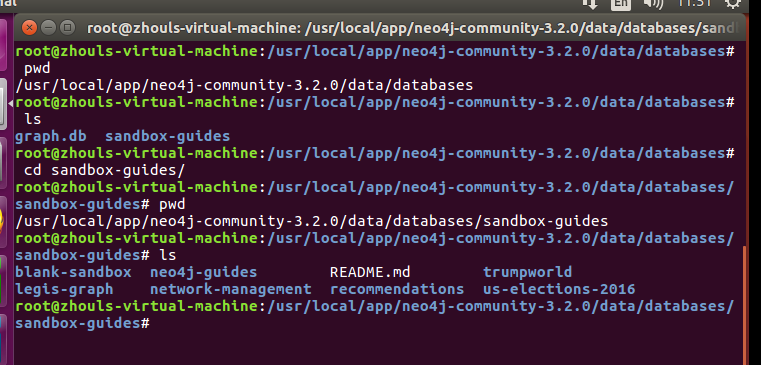
root@zhouls-virtual-machine:/usr/local/app/neo4j-community-3.2./data/databases# pwd
/usr/local/app/neo4j-community-3.2./data/databases
root@zhouls-virtual-machine:/usr/local/app/neo4j-community-3.2./data/databases# ls
graph.db sandbox-guides
root@zhouls-virtual-machine:/usr/local/app/neo4j-community-3.2./data/databases# cd sandbox-guides/
root@zhouls-virtual-machine:/usr/local/app/neo4j-community-3.2./data/databases/sandbox-guides# pwd
/usr/local/app/neo4j-community-3.2./data/databases/sandbox-guides
root@zhouls-virtual-machine:/usr/local/app/neo4j-community-3.2./data/databases/sandbox-guides# ls
blank-sandbox neo4j-guides README.md trumpworld
legis-graph network-management recommendations us-elections-
root@zhouls-virtual-machine:/usr/local/app/neo4j-community-3.2./data/databases/sandbox-guides#
第三步: 初始化
git submodule init

root@zhouls-virtual-machine:/usr/local/app/neo4j-community-3.2./data/databases/sandbox-guides# git submodule init
Submodule 'neo4j-guides' (https://github.com/neo4j-contrib/neo4j-guides.git) registered for path 'neo4j-guides'
root@zhouls-virtual-machine:/usr/local/app/neo4j-community-3.2./data/databases/sandbox-guides#
第四步:升级
git submodule update

root@zhouls-virtual-machine:/usr/local/app/neo4j-community-3.2./data/databases/sandbox-guides# git submodule update
Cloning into 'neo4j-guides'...
remote: Counting objects: , done.
remote: Total (delta ), reused (delta ), pack-reused
Receiving objects: % (/), 156.09 KiB | 5.00 KiB/s, done.
Resolving deltas: % (/), done.
Checking connectivity... done.
Submodule path 'neo4j-guides': checked out '89201c7651b679fb9a487169389ac39ec9cbc00f'
root@zhouls-virtual-machine:/usr/local/app/neo4j-community-3.2./data/databases/sandbox-guides# ls
blank-sandbox neo4j-guides README.md trumpworld
legis-graph network-management recommendations us-elections-
root@zhouls-virtual-machine:/usr/local/app/neo4j-community-3.2./data/databases/sandbox-guides#
第五步
Edit {USE-CASE}/{GUIDE-NAME-HERE}.adoc
这里,跳过
第六步:执行脚本
{USE-CASE}/render.sh [publish]
我这里主要是获取“network-management”数据,所以进入“network-management”文件夹,目录和命令为:

当然,大家也可以进入其他目录下,我这里仅以network-management为例。
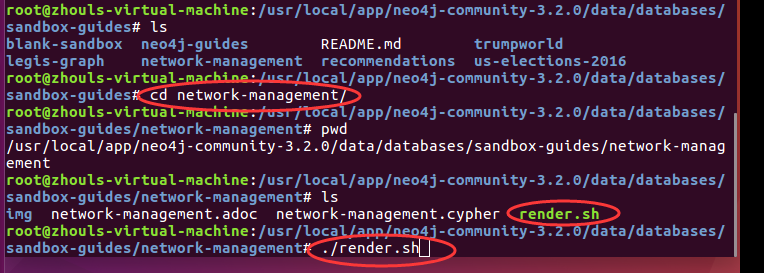
root@zhouls-virtual-machine:/usr/local/app/neo4j-community-3.2./data/databases/sandbox-guides# ls
blank-sandbox neo4j-guides README.md trumpworld
legis-graph network-management recommendations us-elections-
root@zhouls-virtual-machine:/usr/local/app/neo4j-community-3.2./data/databases/sandbox-guides# cd network-management/
root@zhouls-virtual-machine:/usr/local/app/neo4j-community-3.2./data/databases/sandbox-guides/network-management# pwd
/usr/local/app/neo4j-community-3.2./data/databases/sandbox-guides/network-management
root@zhouls-virtual-machine:/usr/local/app/neo4j-community-3.2./data/databases/sandbox-guides/network-management# ls
img network-management.adoc network-management.cypher render.sh
root@zhouls-virtual-machine:/usr/local/app/neo4j-community-3.2./data/databases/sandbox-guides/network-management# ./render.sh
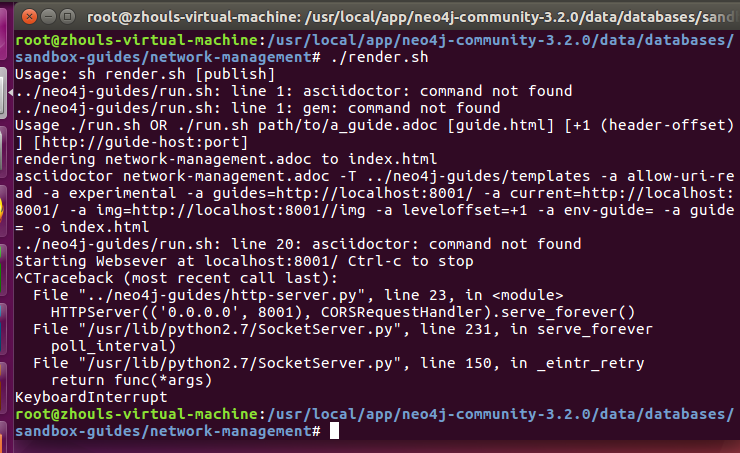
root@zhouls-virtual-machine:/usr/local/app/neo4j-community-3.2.0/data/databases/sandbox-guides/network-management# ./render.sh
Usage: sh render.sh [publish]
../neo4j-guides/run.sh: line 1: asciidoctor: command not found
../neo4j-guides/run.sh: line 1: gem: command not found
Usage ./run.sh OR ./run.sh path/to/a_guide.adoc [guide.html] [+1 (header-offset)] [http://guide-host:port]
rendering network-management.adoc to index.html
asciidoctor network-management.adoc -T ../neo4j-guides/templates -a allow-uri-read -a experimental -a guides=http://localhost:8001/ -a current=http://localhost:8001/ -a img=http://localhost:8001//img -a leveloffset=+1 -a env-guide= -a guide= -o index.html
../neo4j-guides/run.sh: line 20: asciidoctor: command not found
Starting Websever at localhost:8001/ Ctrl-c to stop
^CTraceback (most recent call last):
File "../neo4j-guides/http-server.py", line 23, in <module>
HTTPServer(('0.0.0.0', 8001), CORSRequestHandler).serve_forever()
File "/usr/lib/python2.7/SocketServer.py", line 231, in serve_forever
poll_interval)
File "/usr/lib/python2.7/SocketServer.py", line 150, in _eintr_retry
return func(*args)
KeyboardInterrupt
root@zhouls-virtual-machine:/usr/local/app/neo4j-community-3.2.0/data/databases/sandbox-guides/network-management#
那么就根据提示信息安装“asciidoctor”和“tilt”
在新的命令窗口使用 root 权限执行
apt-get install asciidoctor
gem install tilt


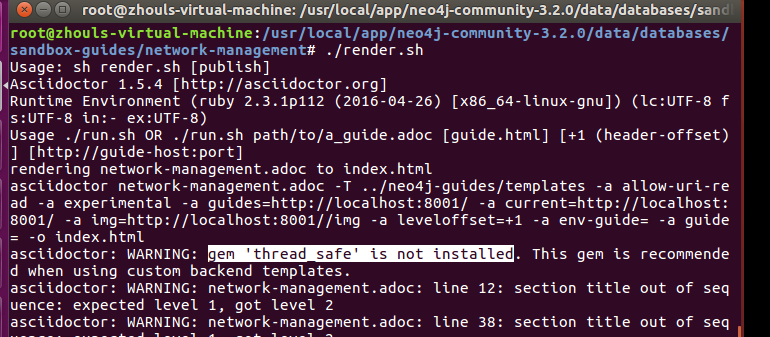

gem install thread_safe
然后,再次执行。
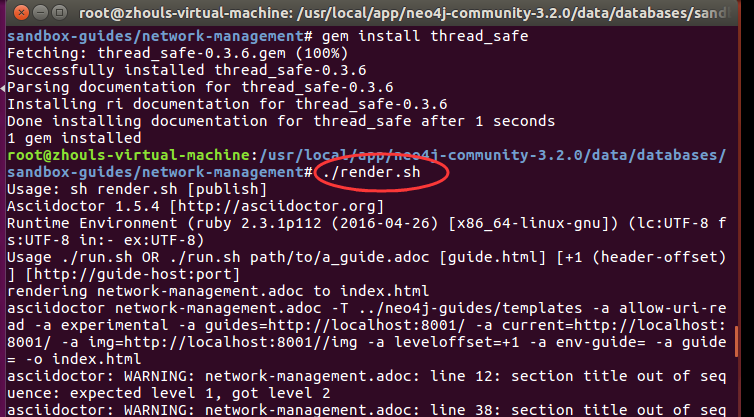
root@zhouls-virtual-machine:/usr/local/app/neo4j-community-3.2./data/databases/sandbox-guides/network-management# ./render.sh
Usage: sh render.sh [publish]
Asciidoctor 1.5. [http://asciidoctor.org]
Runtime Environment (ruby 2.3.1p112 (--) [x86_64-linux-gnu]) (lc:UTF- fs:UTF- in:- ex:UTF-)
Usage ./run.sh OR ./run.sh path/to/a_guide.adoc [guide.html] [+ (header-offset)] [http://guide-host:port]
rendering network-management.adoc to index.html
asciidoctor network-management.adoc -T ../neo4j-guides/templates -a allow-uri-read -a experimental -a guides=http://localhost:8001/ -a current=http://localhost:8001/ -a img=http://localhost:8001//img -a leveloffset=+1 -a env-guide= -a guide= -o index.html
asciidoctor: WARNING: network-management.adoc: line : section title out of sequence: expected level , got level
asciidoctor: WARNING: network-management.adoc: line : section title out of sequence: expected level , got level
asciidoctor: WARNING: network-management.adoc: line : section title out of sequence: expected level , got level
asciidoctor: WARNING: network-management.adoc: line : section title out of sequence: expected level , got level
asciidoctor: WARNING: network-management.adoc: line : section title out of sequence: expected level , got level
asciidoctor: WARNING: network-management.adoc: line : section title out of sequence: expected level , got level
asciidoctor: WARNING: network-management.adoc: line : section title out of sequence: expected level , got level
asciidoctor: WARNING: network-management.adoc: line : section title out of sequence: expected level , got level
asciidoctor: WARNING: network-management.adoc: line : section title out of sequence: expected level , got level
asciidoctor: WARNING: network-management.adoc: line : section title out of sequence: expected level , got level
asciidoctor: WARNING: network-management.adoc: line : section title out of sequence: expected level , got level
asciidoctor: WARNING: network-management.adoc: line : section title out of sequence: expected level , got level
asciidoctor: WARNING: network-management.adoc: line : section title out of sequence: expected level , got level
asciidoctor: WARNING: network-management.adoc: line : section title out of sequence: expected level , got level
asciidoctor: WARNING: network-management.adoc: line : section title out of sequence: expected level , got level
asciidoctor: WARNING: network-management.adoc: line : section title out of sequence: expected level , got level
asciidoctor: WARNING: network-management.adoc: line : section title out of sequence: expected level , got level
Network Management - Introduction
Modeling
DataCenter
Network Exploration: DataCenter and Zones
Network Exploration: Racks
Network Connectivity
Machine types
Machines
Software: Operating Systems and Applications
Software: Running on Machines
Dependency Analysis
Configuration Management
Upgrade OS Version and its Dependencies for a Version Range
IT-Monitoring and Governance
Examples for graph based Network Management Solutions
Monitoring Use-Cases
For instance, minimal, average and maximal runtimes of software instances per type
Data Transer Volume between Interfaces
Resource Management Graph
References
Starting Websever at localhost:/ Ctrl-c to stop
127.0.0.1 - - [/Jun/ ::] "GET / HTTP/1.1" -
127.0.0.1 - - [/Jun/ ::] "GET //img/Network-Management-Model.svg HTTP/1.1" -
127.0.0.1 - - [/Jun/ ::] "GET //img/network-schema-arrows.jpg HTTP/1.1" -
127.0.0.1 - - [/Jun/ ::] "GET //img/network-zones.jpg HTTP/1.1" -
127.0.0.1 - - [/Jun/ ::] "GET //img/network-rack.jpg HTTP/1.1" -
127.0.0.1 - - [/Jun/ ::] "GET //img/network-alternative-routes.jpg HTTP/1.1" -
127.0.0.1 - - [/Jun/ ::] "GET //img/network-8000-machines.jpg HTTP/1.1" -
127.0.0.1 - - [/Jun/ ::] "GET //img/network-rack-machines-type.jpg HTTP/1.1" -
127.0.0.1 - - [/Jun/ ::] "GET //img/network-software-arrows.jpg HTTP/1.1" -
127.0.0.1 - - [/Jun/ ::] "GET //img/network-software-machine.jpg HTTP/1.1" -
127.0.0.1 - - [/Jun/ ::] code , message File not found
127.0.0.1 - - [/Jun/ ::] "GET /favicon.ico HTTP/1.1" -
127.0.0.1 - - [/Jun/ ::] code , message File not found
127.0.0.1 - - [/Jun/ ::] "GET /favicon.ico HTTP/1.1" -
如果还是报错,可以根据提示信息进行处理。我这里是已经成功了。
第七步:打开 web 界面
Open Neo4j Browser and run :play http://localhost:8001/{USE-CASE}
当上一步启动完成后,在浏览器中打开http://localhost:8001/,正常情况下会出现
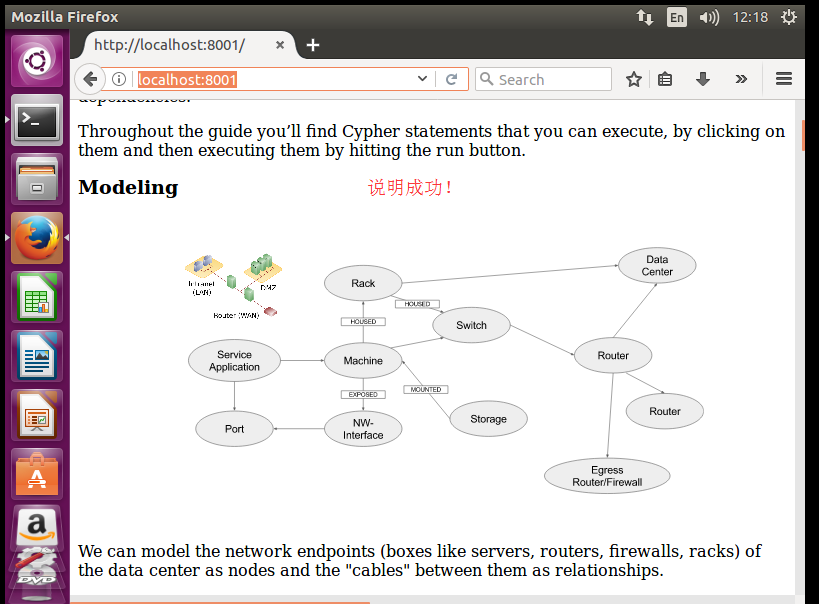
如果看到这个页面,表示说明介绍页面已经正常了,可能会出现乱码,这无所谓,后面会说明如何使用,到时就不会有乱码了。
第八步:导入数据
这一步是关键,也是目的所在,也与 GitHub 上的步骤不同。
我在使用 Neo4j 页面导入的时候会报错,经查找通过 shell 方式导入数据就不会报错,于是采用以下方式:
在 Neo4j 安装目录的bin文件夹中进入cypher-shell,我的具体目录和命令为

root@zhouls-virtual-machine:/usr/local/app/neo4j-community-3.2.# pwd
/usr/local/app/neo4j-community-3.2.
root@zhouls-virtual-machine:/usr/local/app/neo4j-community-3.2.# ls
bin conf import LICENSES.txt logs plugins run
certificates data lib LICENSE.txt NOTICE.txt README.txt UPGRADE.txt
root@zhouls-virtual-machine:/usr/local/app/neo4j-community-3.2.# cd bin/
root@zhouls-virtual-machine:/usr/local/app/neo4j-community-3.2./bin# ls
cypher-shell neo4j neo4j-admin neo4j-import neo4j-shell tools
root@zhouls-virtual-machine:/usr/local/app/neo4j-community-3.2./bin# ./cypher-shell
Ubuntu16.04下Neo4j图数据库官网安装部署步骤(图文详解)(博主推荐)
然后输入用户名和密码连接到 Neo4j 数据库。可以参考我上面的这篇博客。
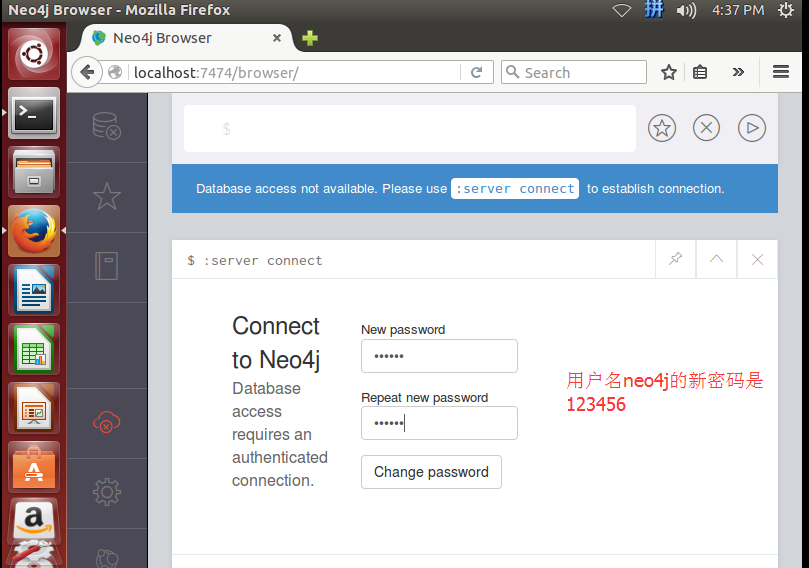
如果大家,遇到如下的问题,请移步
Neo4j下执行cypher-shell时,Connection refused问题解决?
大家,可以看看,沙盒数据里,所带的
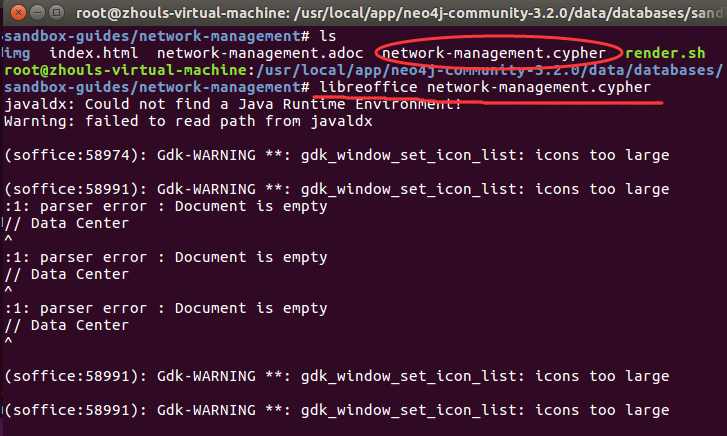
root@zhouls-virtual-machine:/usr/local/app/neo4j-community-3.2./data/databases/sandbox-guides# ls
blank-sandbox neo4j-guides README.md trumpworld
legis-graph network-management recommendations us-elections-
root@zhouls-virtual-machine:/usr/local/app/neo4j-community-3.2./data/databases/sandbox-guides# cd network-management/
root@zhouls-virtual-machine:/usr/local/app/neo4j-community-3.2./data/databases/sandbox-guides/network-management# ls
img index.html network-management.adoc network-management.cypher render.sh
root@zhouls-virtual-machine:/usr/local/app/neo4j-community-3.2./data/databases/sandbox-guides/network-management# libreoffice network-management.cypher
javaldx: Could not find a Java Runtime Environment!
Warning: failed to read path from javaldx (soffice:): Gdk-WARNING **: gdk_window_set_icon_list: icons too large (soffice:): Gdk-WARNING **: gdk_window_set_icon_list: icons too large
:: parser error : Document is empty
// Data Center
^
:: parser error : Document is empty
// Data Center
^
:: parser error : Document is empty
// Data Center
^
然后复制/usr/local/app/neo4j-community-3.2.0/data/databases/sandbox-guides/network-management/network-management.cypher”这个文件里的全部内容到neo4j>,这样就可以顺利创建数据了
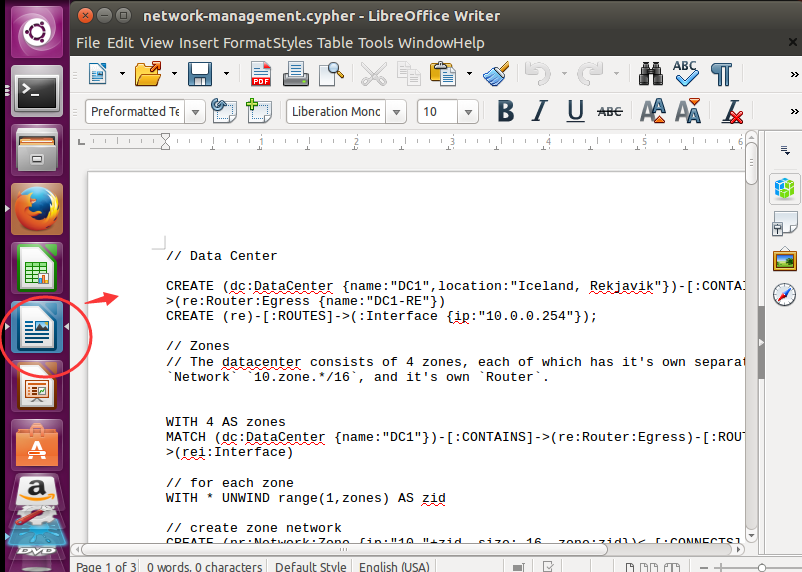
按Ctrl + c 复制,粘贴到neo4j>
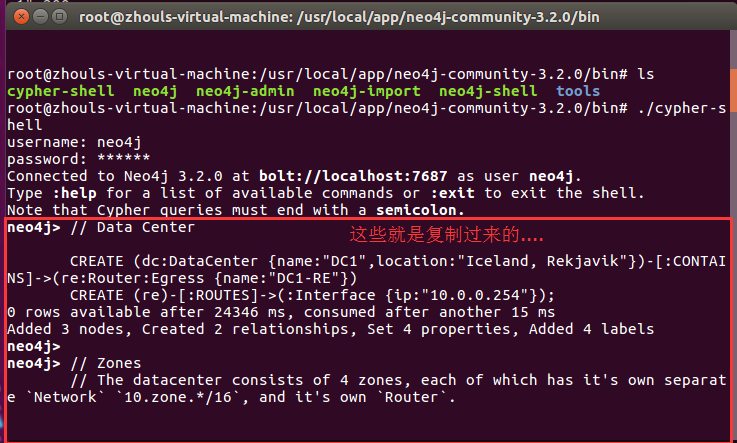
root@zhouls-virtual-machine:/usr/local/app/neo4j-community-3.2./bin# ls
cypher-shell neo4j neo4j-admin neo4j-import neo4j-shell tools
root@zhouls-virtual-machine:/usr/local/app/neo4j-community-3.2./bin# ./cypher-shell
username: neo4j
password: ******
Connected to Neo4j 3.2. at bolt://localhost:7687 as user neo4j.
Type :help for a list of available commands or :exit to exit the shell.
Note that Cypher queries must end with a semicolon.
neo4j> // Data Center CREATE (dc:DataCenter {name:"DC1",location:"Iceland, Rekjavik"})-[:CONTAINS]->(re:Router:Egress {name:"DC1-RE"})
CREATE (re)-[:ROUTES]->(:Interface {ip:"10.0.0.254"});
rows available after ms, consumed after another ms
Added nodes, Created relationships, Set properties, Added labels
neo4j>
neo4j> // Zones
// The datacenter consists of 4 zones, each of which has it's own separate `Network` `10.zone.*/16`, and it's own `Router`. WITH AS zones
MATCH (dc:DataCenter {name:"DC1"})-[:CONTAINS]->(re:Router:Egress)-[:ROUTES]->(rei:Interface) // for each zone
WITH * UNWIND range(,zones) AS zid // create zone network
CREATE (nr:Network:Zone {ip:"10."+zid, size: , zone:zid})<-[:CONNECTS]-(rei) // create router in DC, connect it via an interface to the zone network
CREATE (dc)-[:CONTAINS]->(r:Router {name:"DC1-R-"+zid, zone:zid})-[:ROUTES]->(ri:Interface {ip:nr.ip+".0.254"})-[:CONNECTS]->(nr);
rows available after ms, consumed after another ms
Added nodes, Created relationships, Set properties, Added labels
neo4j>
neo4j>
neo4j> // Racks WITH as racks
MATCH (dc:DataCenter {name:"DC1"})
MATCH (nr:Network:Zone) // one per zone WITH * UNWIND range(,racks) AS rackid CREATE (dc)-[:CONTAINS]->(rack:Rack {name:"DC1-RCK-"+nr.zone+"-"+rackid, rack:rackid, zone:nr.zone})-[:HOLDS]->(s:Switch {ip:nr.ip+"."+rackid, rack:rackid})-[:ROUTES]->(si:Interface {ip:s.ip+".254"})<-[:ROUTES]-(nr);
rows available after ms, consumed after another ms
Added nodes, Created relationships, Set properties, Added labels
neo4j>
neo4j> // Machine types // Similar to the machines you can rent on AWS we use machine types, for which we auto-create some reasonable capacities for CPU, RAM and DISK. WITH ["xs","s","m","l","xl","xxl"] as typeNames
UNWIND range(,size(typeNames)-) as idx
CREATE (t:Type {id:idx, cpu: toInt(^idx), ram:toInt(^idx), disk:toInt(^idx), type: typeNames[idx]})
SET t.name = typeNames[idx]+"-"+t.cpu + "/"+t.ram+"/"+t.disk
RETURN t.name, t.id, t.cpu, t.ram, t.disk;
+----------------------------------------------------+
| t.name | t.id | t.cpu | t.ram | t.disk |
+----------------------------------------------------+
| "xs-1/1/1" | | | | |
| "s-2/4/5" | | | | |
| "m-4/16/25" | | | | |
| "l-8/64/125" | | | | |
| "xl-16/256/625" | | | | |
| "xxl-32/1024/3125" | | | | |
+----------------------------------------------------+ rows available after ms, consumed after another ms
Added nodes, Set properties, Added labels
neo4j>
neo4j>
neo4j> // Machines // Each Rack contains 200 machines of the types we just introduced, so that in total we get 8000 servers in our datacenter.
// The distribution of the types is inverse to their capabilities. MATCH (t:Type)
WITH collect(t) as types, as machines MATCH (rack:Rack)-[:HOLDS]->(s:Switch)-[:ROUTES]->(si:Interface) UNWIND (range(,machines)) AS machineid CREATE (rack)-[:HOLDS]->(m:Machine {id:rack.id * + machineid, name: rack.name + "-M-" +machineid })-[:ROUTES]->(i:Interface {ip:s.ip+"."+machineid})-[:CONNECTS]->(si)
WITH m,types,size(types)-toInt(log(machines - machineid + )) - as idx
WITH m, types[idx] as t
CREATE (m)-[:TYPE]->(t);
rows available after ms, consumed after another ms
Added nodes, Created relationships, Set properties, Added labels
neo4j>
neo4j>
neo4j> // Create OS and Software // https://en.wikipedia.org/wiki/Red_Hat_Enterprise_Linux#Version_history
// https://wiki.ubuntu.com/Releases
// https://en.wikipedia.org/wiki/Debian_version_history WITH
[{name:"RHEL",versions:["7.1","7.2","7.3"]},{name:"Ubuntu",versions:["14.04","16.04","16.10","17.04"]},{name:"Debian",versions:["6-Squeeze","7-Wheezy","8-Jessie"]}] as osNames,
[
{name:"java",versions:[""]},
{name:"neo4j",ports:[,,],versions:["3.0","3.1"],dependencies:["java/8"]},
{name:"postgres",ports:[],versions:["9.4","9.5","9.6"]},
{name:"couchbase",ports:[,,,,,,,,,,],versions:["3.0","4.0","4.5","4.6"]},
{name:"elasticsearch",ports:[,,,],versions:["2.4","5.0","5.1","5.2"],dependencies:["java/8"]}
] as services,
[{name:"webserver",ports:[,],dependencies:["postgres/9.4"]},
{name:"crm",ports:[,],dependencies:["java/8","neo4j/3.1"]},
{name:"cms",ports:[],dependencies:["php","webserver","couchbase"]},
{name:"webapp",ports:[],dependencies:["java","neo4j"]},
{name:"logstash",ports:[],dependencies:["elasticsearch/5.2"]}
] as applications UNWIND osNames + services + applications AS sw CREATE (s:Software) SET s = sw
FOREACH (sw in filter(x IN osNames where x.name = sw.name) | SET s:OS)
FOREACH (sw in filter(x IN services where x.name = sw.name) | SET s:Service)
FOREACH (sw in filter(x IN applications where x.name = sw.name) | SET s:Application) FOREACH (idx in range(,size(coalesce(sw.versions,[]))-) |
MERGE (s)-[:VERSION]->(v0:Version {name:sw.versions[idx]})
MERGE (s)-[:VERSION]->(v:Version {name:sw.versions[idx+]})
MERGE (v0)<-[:PREVIOUS]-(v)
)
WITH *
UNWIND sw.dependencies as dep
WITH *,split(dep,"/") as parts
MERGE (d:Software {name:parts[]})
FOREACH (v IN case size(parts) when then [] else [parts[]] end |
MERGE (d)-[:VERSION]->(:Version {name:v})
)
WITH *
OPTIONAL MATCH (d)-[:VERSION]->(v:Version {name:parts[]})
WITH s, coalesce(v,d) as d
MERGE (s)-[:DEPENDS_ON]->(d);
rows available after ms, consumed after another ms
Added nodes, Created relationships, Set properties, Added labels
neo4j>
neo4j>
neo4j> // Install Software create index on :Software(name);
rows available after ms, consumed after another ms
Added indexes
neo4j>
neo4j> WITH [(:Software:OS)-[:VERSION]->(v) | v] as osVersions
MATCH (a:Application:Software)
WITH osVersions, collect(a) as apps
MATCH (m:Machine)-[:ROUTES]->(i:Interface)
WITH m,i, osVersions[toInt(rand()*size(osVersions))] as os, apps[toInteger(rand()*size(apps))] as app
CREATE (m)-[:RUNS]->(op:OS:Process {name:os.name, startTime:timestamp() - toInteger( (rand() * + ) ***)})-[:INSTANCE]->(os)
CREATE (m)-[:RUNS]->(ap:Application:Process {name: app.name, pid: toInt(rand()*), startTime:timestamp() - toInteger(rand() * ***) })-[:INSTANCE]->(app) FOREACH (portNo in app.ports |
MERGE (port:Port {port:portNo})<-[:EXPOSES]-(i)
CREATE (ap)-[:LISTENS]->(port)
)
WITH *
MATCH (app)-[:DEPENDS_ON]->(dep)
CREATE (m)-[:RUNS]->(dp:Service:Process {name: dep.name, pid: toInt(rand()*), startTime:timestamp() - toInteger(rand() * ***) })-[:INSTANCE]->(dep)
CREATE (ap)-[:DEPENDS_ON]->(dp)
FOREACH (portNo in dep.ports |
MERGE (port:Port {port:portNo})<-[:EXPOSES]-(i)
CREATE (dp)-[:LISTENS]->(port)
);
创建完成后的信息提示如下图
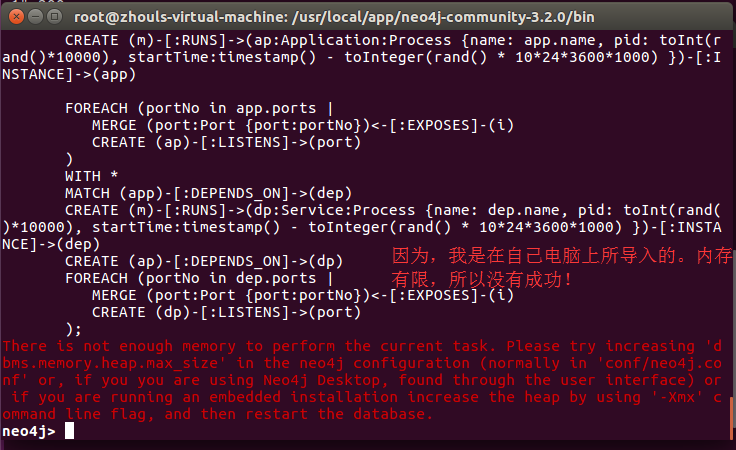
There is not enough memory to perform the current task.
Please try increasing 'dbms.memory.heap.max_size' in the neo4j configuration (normally in 'conf/neo4j.conf' or,
if you you are using Neo4j Desktop, found through the user interface)
or if you are running an embedded installation increase the heap by using '-Xmx' command line flag,
and then restart the database.
为此,我按: exit退出,进行内存大小调整。

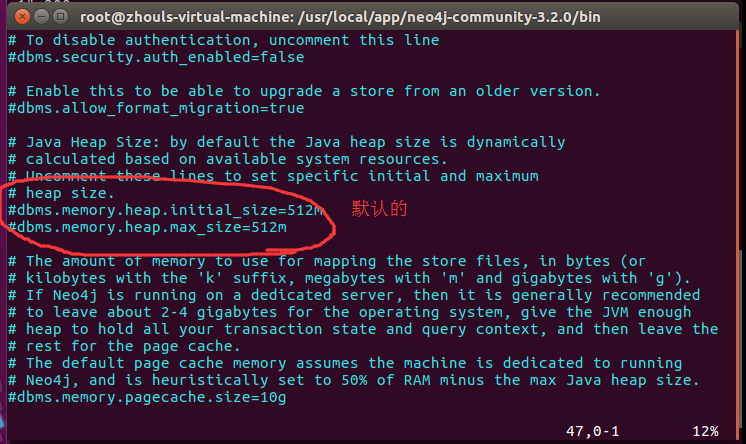
我这里,自行调整内存大小来试试,比如。改为2G吧,来试试!

dbms.memory.heap.max_size=2g
查看导入到Neo4j数据库后的沙盒数据之network-management
启动 Neo4j
root@zhouls-virtual-machine:/usr/local/app/neo4j-community-3.2./bin# ./neo4j console
在浏览器中打开:http://localhost:7474/ 进入 Neo4j 的 web 界面,
点击左上角的数据库图标就会显示刚才导入的数据节点标签、关系等信息。
在命令行中输入:play http://localhost:8001/会显示在第 4 步中显示的介绍说明信息,这时可以按照说明信息查看操作。
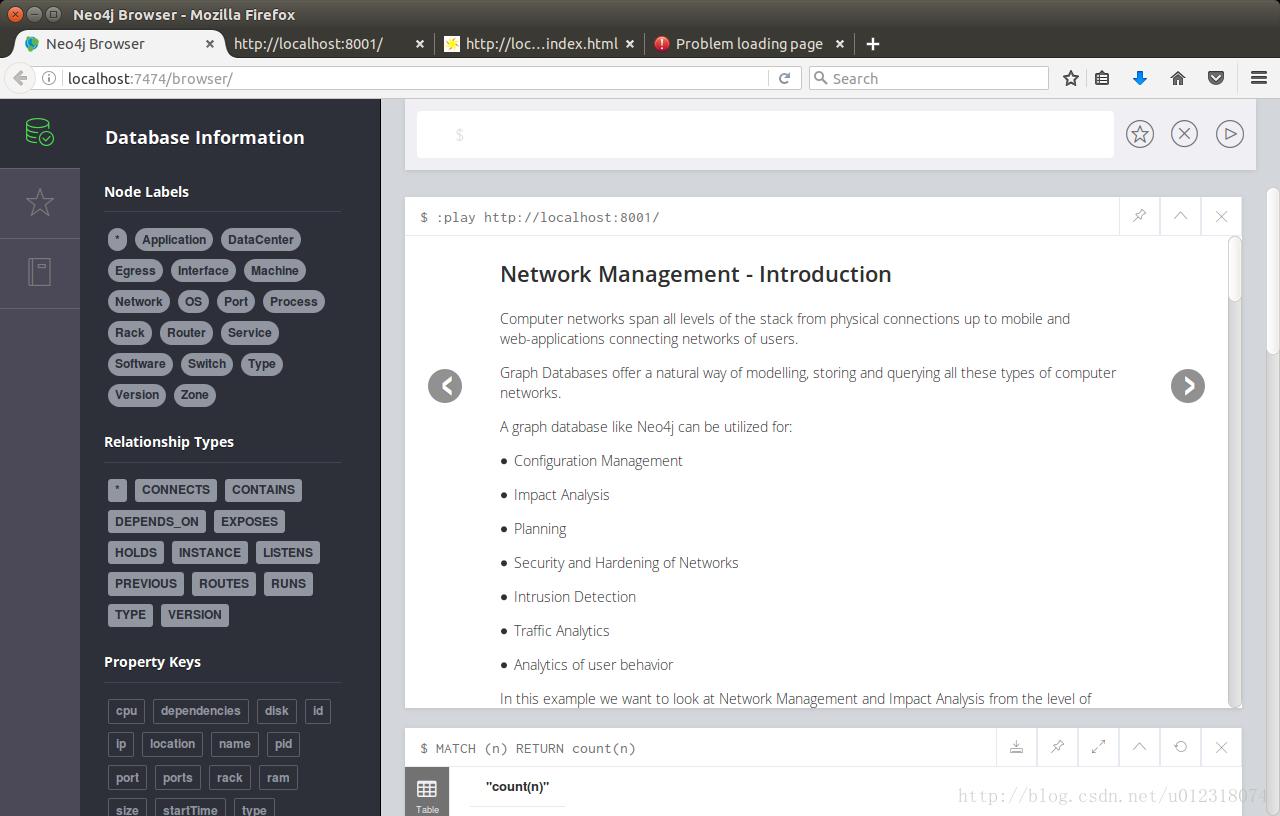
成功!
Ubuntu16.04下沙盒数据导入到 Neo4j 数据库(图文详解)的更多相关文章
- Ubuntu14.04下沙盒数据导入到 Neo4j 数据库(图文详解)
不多说,直接上干货! 参考博客 http://blog.csdn.net/u012318074/article/details/72793914 (表示感谢) 前期博客 Neo4j沙盒实验申请过程 ...
- Ubuntu16.04下Mongodb官网卸载部署步骤(图文详解)(博主推荐)
不多说,直接上干货! 前期博客 Ubuntu16.04下Mongodb官网安装部署步骤(图文详解)(博主推荐) https://docs.mongodb.com/manual/tutorial/ins ...
- Ubuntu16.04下Mongodb官网安装部署步骤(图文详解)(博主推荐)
不多说,直接上干货! 在这篇博客里,我采用了非官网的安装步骤,来进行安装.走了弯路,同时,也是不建议.因为在大数据领域和实际生产里,还是要走正规的为好. Ubuntu16.04下Mongodb(离线安 ...
- Ubuntu14.04下Mongodb官网卸载部署步骤(图文详解)(博主推荐)
不多说,直接上干货! 前期博客 Ubuntu14.04下Mongodb官网安装部署步骤(图文详解)(博主推荐) https://docs.mongodb.com/manual/tutorial/ins ...
- Neo4j沙盒实验申请过程步骤(图文详解)
不多说,直接上干货! 参考博客 http://blog.csdn.net/u012318074/article/details/72793632 (对此表示感谢) 前期博客 我暂时是将Neo4j ...
- Ubuntu14.04下Mongodb官网安装部署步骤(图文详解)(博主推荐)
不多说,直接上干货! 在这篇博客里,我采用了非官网的安装步骤,来进行安装.走了弯路,同时,也是不建议.因为在大数据领域和实际生产里,还是要走正规的为好. Ubuntu14.04下Mongodb(离线安 ...
- CentOS 6.3下Samba服务器的安装与配置方法(图文详解)
这篇文章主要介绍了CentOS 6.3下Samba服务器的安装与配置方法(图文详解),需要的朋友可以参考下 一.简介 Samba是一个能让Linux系统应用Microsoft网络通讯协议的软件, ...
- 全网最详细的IDEA里如何正确新建普通的Java web项目并发布到Tomcat上运行成功【博主强烈推荐】(类似eclipse里同一个workspace下【一个子项目】并存)(图文详解)
不多说,直接上干货! 首先,大家要明确,IDEA.Eclipse和MyEclipse等编辑器之间的新建和运行手法是不一样的. 如果是在Myeclipse里,则是File -> new -> ...
- Windows 7操作系统下PHP 7的安装与配置(图文详解)
前提博客 Windows 7操作系统下Apache的安装与配置(图文详解) 从官网下载 PHP的官网 http://www.php.net/ 特意,新建这么一个目录 ...
随机推荐
- 更换WordPress编辑器为TinyMCE Advanced
WordPress自带的编辑器功能很少,连更换字体样式大小都不行,没关系WordPress的插件中心插件非常多 在插件中心搜索TinyMCE Advanced 安装启用 还没完 点击设置 里面有丰富的 ...
- Java学习-课堂总结
一.字符串比较方式 1)‘==’ 地址值比较 2) equals()方法 内容比较 二.String类的两种实例化方式 1)String str=“Hello”: 2 ...
- linux抓包命令-tcpdump命令详解
最近调试支付接口的时候,遇到了一个奇怪的问题:我按照支付接口文档,对接支付通道,当消费业务正常后,调试查余和冲正的时候,支付通道的对接技术告诉我,系统没有我们支付系统的请求报文,数据库和日志中都没有, ...
- UVa 1585 待解决
是在遇到第一个ooxx的时候会出错,会少算一个1 #include<stdio.h> int main() { int i,k=0,sum=0; char a[100]={"oo ...
- 【转】【Oracle 集群】Oracle 11G RAC教程之集群安装(七)
原文地址:http://www.cnblogs.com/baiboy/p/orc7.html 阅读目录 目录 集群安装 参考文献 相关文章 Oracle 11G RAC集群安装(七) 概述:写下本文档 ...
- 【BZOJ2733】【HNOI2012】永无乡 - 线段树合并
题意: Description 永无乡包含 n 座岛,编号从 1 到 n,每座岛都有自己的独一无二的重要度,按照重要度可 以将这 n 座岛排名,名次用 1 到 n 来表示.某些岛之间由巨大的桥连接,通 ...
- [置顶]
来自 HeroKu 的 HTTP API 设计指南(中文版)
转载:http://get.jobdeer.com/343.get 来自 HeroKu 的 HTTP API 设计指南(中文版) 翻译 by @Easy 简介 本指南中文翻译者为 @Easy ,他是国 ...
- P1265 公路修建 (prim)
题目描述 某国有n个城市,它们互相之间没有公路相通,因此交通十分不便.为解决这一"行路难"的问题,政府决定修建公路.修建公路的任务由各城市共同完成. 修建工程分若干轮完成.在每一轮 ...
- 新手学python-Day1-鸡汤,变量,编码,进制,判断
作业要求为编写一个登录接口:`输入用户名密码`认证成功后显示欢迎信息`输错三次锁定做完作业以后,使用ctrl+alt+f格式化一下,特别舒爽 1 def jilu(str): 2 zt = open( ...
- JAVA基础知识复习小结
集合 Set集合 Set集合的基本特征是元素不允许重复.HashSet不保存元素顺序,LinkedHashSet用链表保持元素的插入顺序,TreeSet可定制排序规则. HashSet的底层是用Has ...
